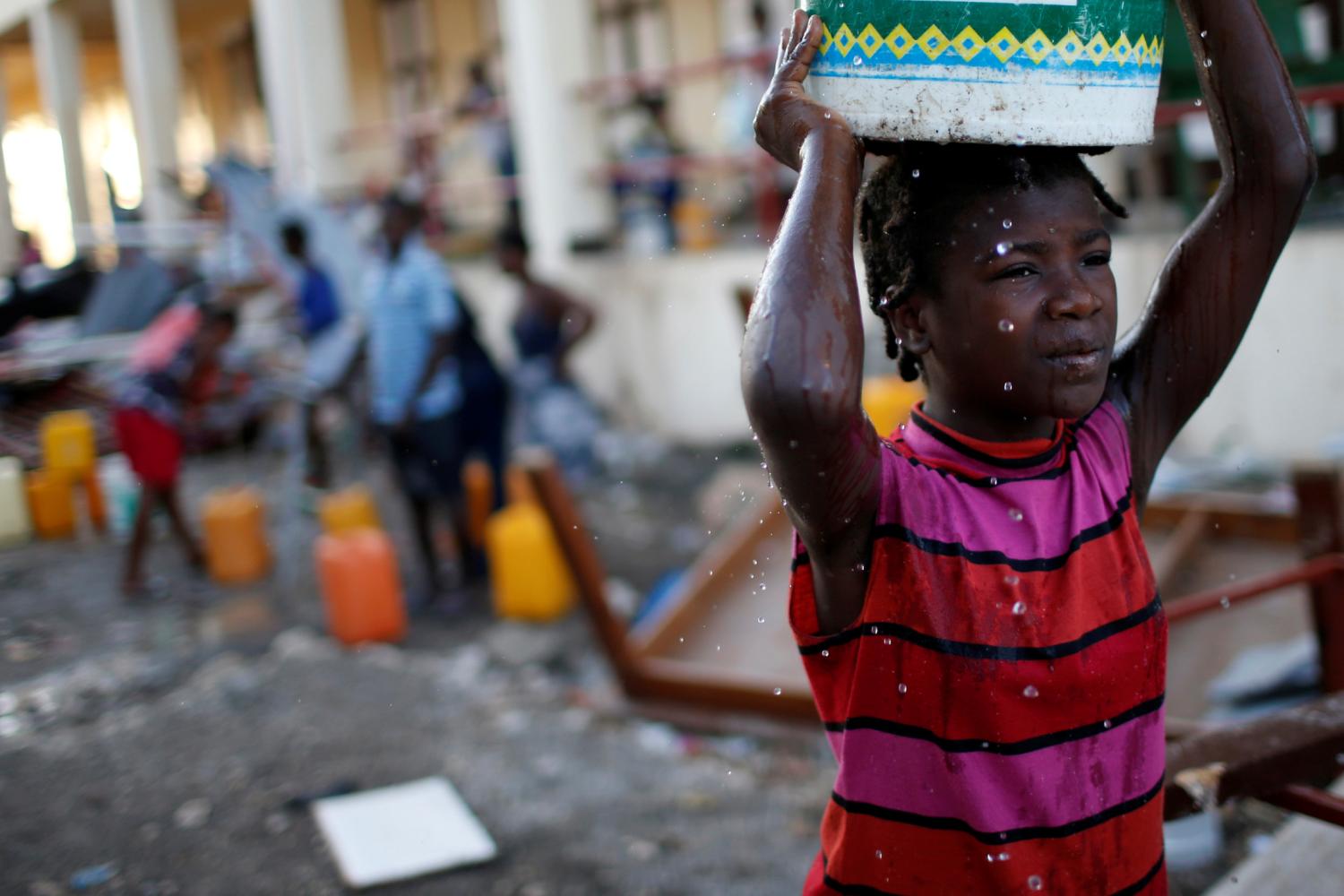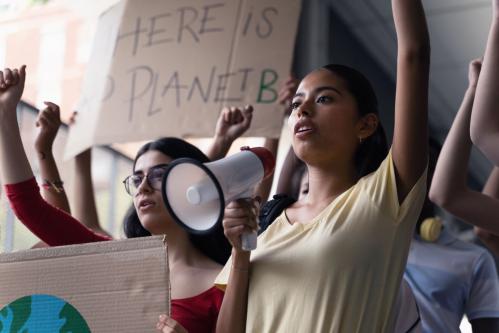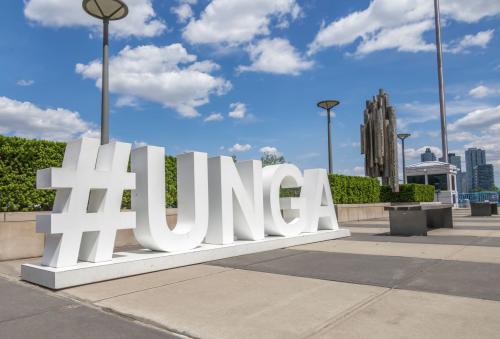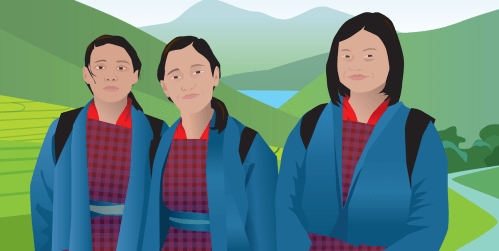The intensifying impacts of climate change and its indiscriminate nature make climate change adaptation and mitigation a high priority for countries around the globe. Disasters caused by droughts, wildfires, tropical cyclones, and floods have wreaked havoc on people’s lives everywhere, from Japan to Bangladesh, from the United States to Afghanistan, from Peru to Fiji. From 1850 to 2011 countries in the developing world were responsible for only 21 percent of carbon emitted, yet in 2015 they paid 78 percent of the social cost of climate change through their greater exposure to natural disasters, weaker infrastructure, and less reserve capital on which to fall back. Developing countries’ share of the social cost is expected to rise to 87 percent by 2035, and be accompanied by the irretrievable loss of indigenous knowledge systems that could provide key climate change adaptation solutions.
The most vulnerable and least skilled members of these populations, largely women and girls, experience most acutely the impact of climate change, particularly extreme weather events. Evidence shows that natural disasters lower women’s life expectancy more than men’s, and in some cases women and girls make up as much as 90 percent of those killed in weather-related disasters. Further, women and girls are increasingly vulnerable to human trafficking or to sexual assault in crowded shelters or camps when they survive. They are also often excluded from participating in decisionmaking within the household and community, or in risk-reduction activities that could expose them to life-saving information, resources, and skills.
In families experiencing climate change’s gradual or prolonged effects, such as drought, girls—who already face an array of gender-based challenges—often endure the most consequential long-term impacts of short-term coping responses. For example, girls are at greater risk of early marriage in times of weather-related crises, because their dowries can help ease the burden of scarce household resources; and they are often the first to be withdrawn from school or they attend school less frequently in times of drought so that they can complete household responsibilities like fetching water. These coping mechanisms direct resources away from opportunities that would otherwise change the course of girls’ futures, and instead force them to stay in existing conditions of poverty, vulnerability, and marginalization that perpetuate low-skill development.
Climate change increases humanity’s vulnerability to the shocks of weather-related disasters; it also exacerbates existing gender inequalities that obstruct opportunities for girls’ and women’s social and economic empowerment. The negative effects of climate change have direct implications for programs and policies that target positive life outcomes for marginalized and vulnerable girls. Ignoring this and how girls and women can be change agents in the push for climate action can backfire. It could halt or reverse some of the progress made toward achieving cross-cutting targets of the Sustainable Development Goals (SDGs). This includes advances related to Goals 1 (no poverty), 4 (quality education), 5 (gender equality), 8 (decent work and economic growth), 10 (reduced inequalities), 11 (sustainable cities and communities), 12 (responsible consumption and production), and 13 (climate action).
The global community knows that the 17 SDGs are intricately intertwined and interdependent, and that innovative partnerships and outside-the-box thinking are prerequisites to achieving Agenda 2030. Women Deliver and the Global Partnership for Education, for example, have illustrated how progress in gender equality and education, respectively, lie at the center of each of the global goals. However, although the gender and education communities have each addressed climate change adaptation and mitigation in their own ways, the identification of problems and solutions has been confined to the gender, education, and climate change sectors from which they have stemmed and, thus, have failed to integrate on the whole (Figure 1).
Figure 1: Current landscape of approaches to climate action

On one side (A in Figure 1), actors from the gender and climate change sectors have engaged in discussions that have highlighted the important role of increasing women’s participation in community-led adaptation efforts. While the approaches initiated in this space have included adult education, the actions engendered here have missed the important link to quality education throughout life from early childhood through adolescence to adulthood. Establishing this link is particularly crucial, given the high rates of dropout by girls, due to gender-discriminatory social norms and practices, once they reach secondary school. Consequently, efforts to give voice to women may fall short because interventions fail to take into account the cumulative social and psychological effects of years of being denied access to a quality education. On the other side (B in Figure 1), education and climate change dialogues have done much to engage citizens at a young age, so as to spur important behavior change among children to reduce their vulnerability to the negative impact of climate change. However, these efforts have emerged as gender-blind. As a result, efforts to improve the adaptive capacity of the next generation may fall short because climate change education fails to recognize the disproportionate vulnerability shouldered by girls stemming from structural inequalities and constraining gender norms. Finally, although gender and education actors have done much to advance issues in girls’ education (C in Figure 1), these discussions remain largely disconnected from issues of climate change. The extent to which educators could team up with climate activists and gender specialists to contribute to climate adaptation and mitigation efforts remains largely unexplored.
Figure 2: Integrated approaches to climate action

To improve the efficiency and effectiveness of climate change interventions—and to avoid pitfalls such as those mentioned above—this paper proposes that actors approaching climate action through the gender, education, and climate change sectors come together through multisectoral partnerships and collaboration, as illustrated in Figure 2, rather than in separate, isolated occasions, as in Figure 1. To demonstrate how, this paper draws on research in girls’ education specifically and on gender and education more broadly to highlight three platforms around which these three sectors could link up knowledge and action to lift up girls and women as agents of change in the pursuit of sustainable development and more equitable climate action:
1. Promote girls’ reproductive rights in order to ensure equitable climate action. The first platform is centered on enhancing girls’ and women’s reproductive health and rights, an argument that pushes current discussions on “female education,” women’s fertility, and population growth to consider how the underlying lever of change is education’s impact on girls’ and women’s control over their reproductive lives. Making the connection to female rights and agency has important implications not only for providing girls and women the opportunities to develop their own human, social, and political capital, but also for ensuring more equitable climate action.
2. Invest in girls’ education in order to foster climate participation and leadership. The second platform draws attention to the role that women in leadership and decisionmaking have in increasing the diversity of experiences and perspectives shaping climate change problem identification and policy solutions. This case points to the critical importance of education, both in formal and informal spaces, in setting girls up to take on leadership roles later in life.
3. Develop girls’ life skills for a green economy. The third platform focuses on increasing girls’ and women’s skills for a green economy, and how an investment in girls’ quality education—one that builds the breadth of skills needed not only for a changing world but also for transforming a girl’s world—can be the key to ensuring that girls and women fully participate in sustainable development and have equal opportunity to drive and benefit from greener innovations in the 21st century.
While girls’ education is one of many promising and cost-effective solutions to climate change, investing in girls’ education comes down to increasing humanity’s capacity to develop diverse technical and sociological solutions for adapting to and mitigating against climate change. Indeed, investment in girls’ education is a foundational strategy for addressing the underlying gender inequalities driving much of the unequal impacts of climate change experienced by girls and women, as well as those threatening the achievement of the SDGs.
Download the report »
The Brookings Institution is committed to quality, independence, and impact.
We are supported by a diverse array of funders. In line with our values and policies, each Brookings publication represents the sole views of its author(s).




